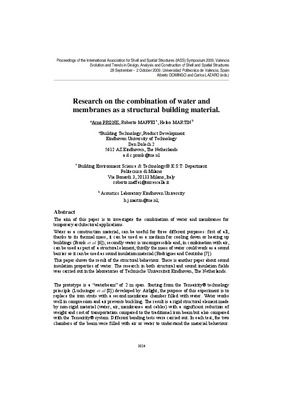JavaScript is disabled for your browser. Some features of this site may not work without it.
Buscar en RiuNet
Listar
Mi cuenta
Estadísticas
Ayuda RiuNet
Admin. UPV
Research on the combination of water and membranes as a structural building material
Mostrar el registro sencillo del ítem
Ficheros en el ítem
| dc.contributor.author | PRONK, Arno
|
|
| dc.contributor.author | MAFFEI, Roberto
|
|
| dc.contributor.author | MARTIN, Heiko
|
|
| dc.contributor.editor | Domingo Cabo, Alberto
|
es_ES |
| dc.contributor.editor | Lázaro Fernández, Carlos Manuel
|
es_ES |
| dc.date.accessioned | 2009-12-18T11:03:41Z | |
| dc.date.available | 2009-12-18T11:03:41Z | |
| dc.date.issued | 2009-12-18T11:03:41Z | |
| dc.identifier.isbn | 978-84-8363-461-5 | |
| dc.identifier.uri | http://hdl.handle.net/10251/6707 | |
| dc.description | p. 3024-3033 | en_EN |
| dc.description.abstract | The aim of this paper is to investigate the combination of water and membranes for temporary architectural applications. Water as a construction material, can be useful for three different purposes: first of all, thanks to its thermal mass, it can be used as a medium for cooling down or heating up buildings (Pronk et al [6]); secondly water is uncompressible and, in combination with air, can be used as part of a structural element; thirdly the mass of water could work as a sound barrier so it can be used as sound insulation material (Rodrigues and Coutinho [7]). This paper shows the result of the structural behaviour. There is another paper about sound insulation properties of water. The research in both structural and sound insulation fields was carried out in the laboratories of Technische Universiteit Eindhoven, The Netherlands. The prototype is a "waterbeam" of 2 m span. Starting from the Tensairity(R) technology principle (Luchsinger et al [8]) developed by Airlight, the purpose of this experiment is to replace the iron struts with a second membrane chamber filled with water. Water works well in compression and air prevents buckling. The result is a rigid structural element made by non-rigid material (water, air, membranes and cables) with a significant reduction of weight and cost of transportation compared to the traditional iron beam but also compared with the Tensairity(R) system. Different bending tests were carried out. In each test, the two chambers of the beam were filled with air or water to understand the material behaviour.The comparison between the results shows that water works slightly better than air (stiffness increase of a range of 8-13% in the elements filled with water). Water application in architecture showed promising results. Further investigation (pure compression tests on columns, multiple layers sound barrier) should be carried out. These results could give architects new design opportunities and solutions concerning temporary buildings and moveable architecture. Moreover the company and building construction industry could develop innovative structural elements and new insulation components. | en_EN |
| dc.language | Inglés | en_EN |
| dc.publisher | Editorial Universitat Politècnica de València | es_ES |
| dc.relation.ispartof | Symposium of the International Association for Shell and Spatial Structures (50th. 2009. Valencia). Evolution and Trends in Design, Analysis and Construction of Shell and Spatial Structures : Proceedings | en_EN |
| dc.rights | Reserva de todos los derechos | en_EN |
| dc.subject | Membrane | en_EN |
| dc.subject | Pneumatic beam | en_EN |
| dc.subject | Tensairity system | en_EN |
| dc.title | Research on the combination of water and membranes as a structural building material | en_EN |
| dc.type | Comunicación en congreso | en_EN |
| dc.rights.accessRights | Abierto | es_ES |
| dc.description.bibliographicCitation | Pronk, A.; Maffei, R.; Martin, H. (2009). Research on the combination of water and membranes as a structural building material. Editorial Universitat Politècnica de València. http://hdl.handle.net/10251/6707 | es_ES |
| dc.relation.conferencename | Symposium of the International Association for Shell and Spatial Structures | es_ES |
| dc.relation.conferencedate | 2009 | es_ES |
| dc.relation.conferenceplace | Valencia | es_ES |






